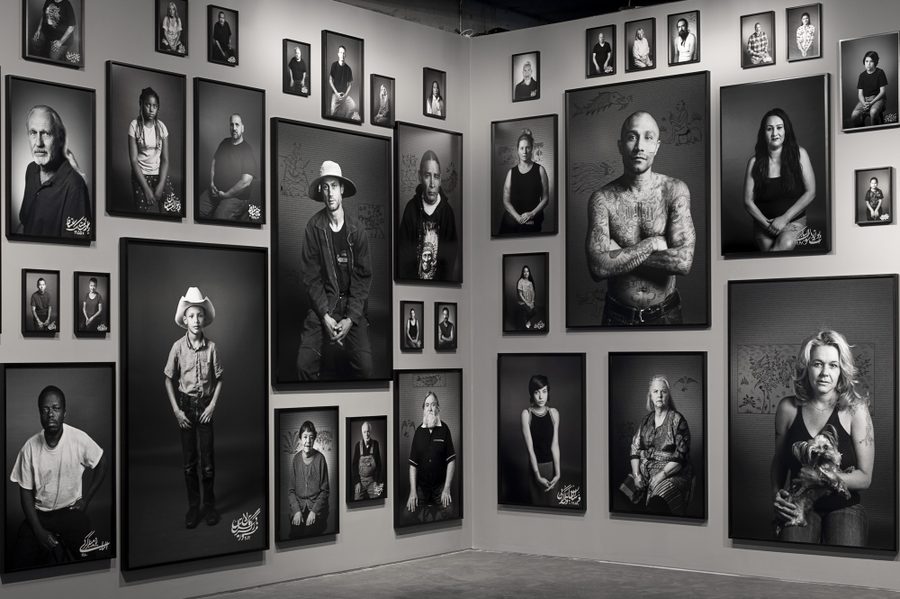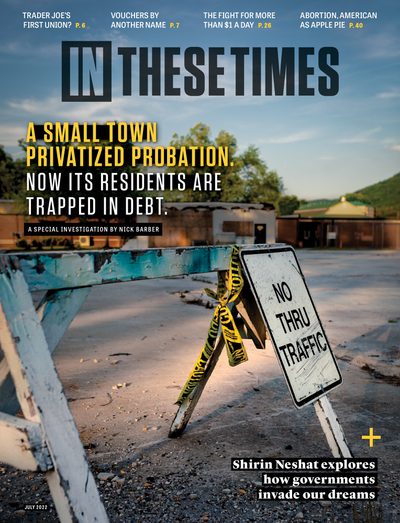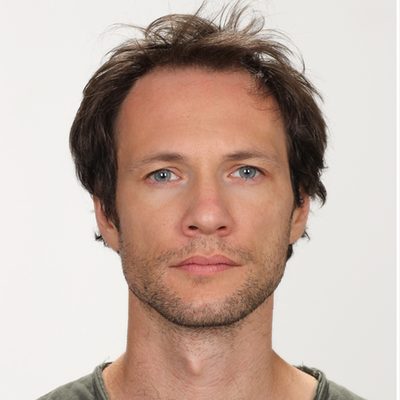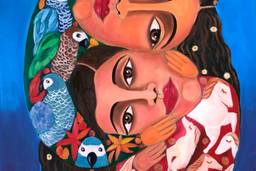An Iranian Artist in Exile Turns Her Camera to the West
Shirin Neshat explores how the government invades our dreams.
Matt A. Hanson

Iranian American artist Shirin Neshat experienced her share of Islamophobia shortly after 9/11, from getting kicked out of a cafe to being deterred by Christian churchgoers from attending a prayer service. “After 9/11, it was enough that you were Muslim,” she tells In These Times. More recently, the Trump presidency saw the “Muslim ban” and “a conversation about treating Muslims like they did with Japanese [during WWII] … incarcerating Muslim people and putting them in camps.”
These experiences of marginalization influenced Neshat’s artistic practice. Earlier in her career, she focused on her nostalgia for Iran and her pain at the separation. In 1975, Neshat left Iran to study art at the University of California, Berkeley. Fearing the Iranian government’s crackdowns on women after the Iranian Revolution in 1979, Neshat did not visit Iran again until 1990.
Neshat is one of the most outspoken artists in America’s Iranian diaspora. In self-imposed exile, she has produced poignant works of video and photography, including “Women of Allah” (1993 – 1997) and “Turbulent” (2002), reflecting on the displacement of women’s rights and artistic freedom from Iran’s Islamist regime.
In 2013, Neshat produced a series of portrait photographs, “Our House is on Fire,” framing the expressive, weeping faces of Egyptians impacted by the revolutions of the Arab Spring. The series marks a break from her stoic portraiture and evokes a sense of solidarity — from her Iranian heritage, to the dreaming revolutionaries of Cairo, to the heavy Persian influences across Azeri society, whose people share much of their history with Iran. Neshat grew up close to the border dividing Iran and Azerbaijan, and speaks wistfully of the undivided history of the land (her husband’s surname is Azerbaijani).
Through photography and filmmaking, Neshat critiques the authoritarian power of national governments, from Iran to the United States and beyond, particularly the way they label their residents in documents like passports and census records. “The Colony” (2019), exhibited at Istanbul’s Dirimart gallery as part of one of Neshat’s latest shows, Land of Dreams, explores a fictional, underground Iranian bureaucracy hidden in an American desert. There, the dreams of local residents are recorded. The piece is half of a two-channel video installation at Dirimart, a Middle Eastern gallery that continues to exhibit Neshat’s work.
The Dirimart exhibit also includes Neshat’s portraits of low-income people in Albuquerque, N.M., America’s fourth-poorest state. The series goes further than physical appearances and explores involuntary, subconscious visions. Certain portraits include the names and birthdates of their subjects in Farsi calligraphy, Neshat marking her specific cultural perspective. Others are interwoven with illustration and calligraphy from an early 13th-century cosmographic bestiary, The Wonders of Creatures and the Marvels of Creation, by Zakariya al-Qazwini (who was from Neshat’s birthplace of Qazvin) — paralleling the medieval Persian mystic with America’s disillusioned dreamers. The narrative arc and overall theme can be read as a metaphor for the subliminal, psychological pervasions of authoritarianism.
Like Neshat’s contemporaries Mona Hatoum (exiled to London in the midst of the Lebanese civil war) and Zehra Doğan (who endured imprisonment and exile from her native Turkey as a political Kurdish painter), Neshat is steadfast in her engagement with issues concerning women born under Islamist regimes and their work in the West.
Neshat spoke with In These Times about searching for transnational relationships, defying nationalist assimilation, examining her place in the United States, and the inspiration she gleans from marginalized realities — after 43 years of exile in the United States.
Matt Hanson: In Land of Dreams, you explore the idea of there being a shared source of creativity that wells up from a collective unconscious. What can the dreams of marginalized people say about the overarching structural injustice that they experience in their waking lives?
Shirin Neshat: Dreams often embody our fears and anxieties, so it’s not just about dreams, but people’s nightmares. A lot of times, that is economic, political and existential. For me, “the land of dreams” can turn into a land of nightmares for a lot of marginalized communities. It’s talking about a collective nightmare that we are experiencing.
There’s something very unanimously common in all of the images, this expression of melancholy and fear. I don’t know how this happens, but for me, if you stand in the room and you’re faced with all of these different portraits, what they have in common is this feeling of anxiety, worry, fear and melancholy. What is inscribed behind them is really about people trying to express their anxieties and both their dreams and nightmares embody that.
It’s really a very poetic narrative. If you see the video [in the exhibition], you go into the dreams of the military man. He imagines a nuclear holocaust, like Hiroshima. He’s worried about the end of the world. People are worried, whether about displacement, violence or abandonment. These are the kinds of things I try to focus on.
If you extract the fictional, poetic symbolism out of my artwork, all that remains is the information. It takes away the meaning. That’s how I function: more like a poet who’s a political artist. I think that fiction can be more truthful than reality. That’s why I’m delving into this connection between the conscious and the subconscious, dreams and reality.
Matt: Land of Dreams is the first time you focused on America for the subjects of your artwork. Why now, and not before?
Shirin: Something has shifted in American society since I’ve been here. I’ve been here since I was 17. Everything is shifting very dramatically toward a more conservative and more fanatic America. There’s this great divide between Republicans and Democrats, liberals and conservatives, but more so there is an impact on immigrants.
I can’t even go back to Iran. As an artist who has forever focused on Iranian society or the Middle East in my work, it felt too exhausting to always function in this nostalgic way. I keep making work about a country that I don’t have a relationship with in terms of going back.
I never felt I had the license to make work about America, because I felt that I wasn’t born in this country. Only since Trump came into power, and when things started going crazy, I felt that it was very important to give my perspective as an immigrant who has the advantage of knowing America for a long time.
I had this revelation that my subjects and concepts don’t have to be about Iranian society or the Arab society, or Muslim society. It really can expand to be about humanity at large.
Matt: Can you speak more about how immigration ties into your work?
Shirin: Thinking about this wall between Mexico and America, and the whole treatment of Mexican immigrants, it’s just atrocious.
Every one of my works is politically charged. For me, being an immigrant and going to New Mexico, as it houses many Hispanic immigrants, it was really important to focus on the marginalized communities. I live in Bushwick, New York, a land of immigrants, mainly Hispanic immigrants from Ecuador, Colombia, Mexico, Dominican Republic, Central to South America. These are the very poor, working-class people, many of them maybe don’t have proper paperwork. I see them struggling and living on the fringes of this country’s blessing, and at the same time, giving so much.
And so my whole argument, with Land of Dreams, is how can we even question or think about America as a purified culture with the white race when, in fact, it’s the people — and really their blood — that made this country. To this day, I see the contribution of these immigrants to build America. To me it’s so unacceptable, that argument, to make this a white America, with the rise of white supremacists.
Matt: What was your process when approaching people, and after that, choosing photographs, toward the expression of a common emotion? I’m thinking of the emotional progression that you’ve depicted in your photo series, from the stoicism of “Women of Allah,” to the sadness of “Our House is on Fire,” and now, the anxiety of Land of Dreams.
Shirin: Something changed in me since “Women of Allah” and “The Book of Kings,” where I became more interested in photographing average people, not models, not myself. I think that was a big turning point for me. That took me to communities that I wouldn’t normally go to. It provoked this activist in me in the way that you really go close to the reality of people’s lives. You really get to know them.
In the case of “Our House is on Fire,” I went to Cairo and did this project for the Robert Rauschenberg Foundation. The idea was to recruit older, elderly men and women in a very religious, Muslim, community. Basically they were really impacted by the revolution, in a really negative way. As you know, since there was an attack at a mosque, many were killed. Also, many had children who were arrested or killed.
For me it was a question of whether or not I could recruit people who really suffered, and could I talk to them and have them share their experiences, and grieve with me. That’s what we did. I brought a translator, I brought them people. We photographed them in Cairo, right near Tahrir Square. It was after that when I was so fascinated by really coming close to people and creating this bond, it’s so profound and beautiful. I went to Azerbaijan and did another project [“The Home of My Eyes”] that I won’t expand on but it was with real people.
And then, with Land of Dreams, literally I followed 200 people who were homeless, right out of prison, middle-class, functional, dysfunctional. I really enjoyed this idea of being a photographer out of my comfort zone and then getting to know people.
Matt: In your work, using photography and film, do you intend to brighten the media spotlight on Iran, especially considering your stance that, since the Green Movement of 2009 and the recent protests in Iran which took place from 2019 to 2020, America’s media attention concerning Iran has dwindled?
Shirin: Before this, I never made work that directly referenced politics, except my work about the 2009 Iranian Green Movement [“The Book of Kings”]. That was very conceptual and much more symbolic in terms of how activism, patriotism and nationalism intersect with violence and brutality across the world from the Arab Spring to the Green Movement. I used the images from the 10th-century Book of Kings by the famous mystic Ferdowsi, who also made long, epic poems about tales of heroism and the history of the Iranians fighting against the Arab conquest and being beheaded.
I was paralleling, in a very symbolic way, the history of Iran from its ancient history to the contemporary, and how the history tends to repeat itself. Every time you have these heroes who are fighting for their nation, they’re also facing violence and brutality. This idea of love, of a nation, is always faced with death and genocide. The images were all projecting love but also extreme brutality.
Matt: Your place of birth, Qazvin, Iran, features in Land of Dreams in the form of calligraphy from a medieval manuscript written there. Can you speak more on your relationship to Iran?
Shirin: I will always make work that threads Iran and my own personal history and culture in the work that I am doing. With Land of Dreams I was wondering if it was going to be stupid or a mishmash of this and that, but I feel like it was a real milestone for me, to find a new way of bridging my past to the present, Iran and America.
The last thing I want to say is that being able to read the writings of a cosmologist from 13th-century Iran on the faces of a Native American in New Mexico, or a Mexican immigrant, I think there’s something profound about that connection, this bonding, these intersections of culture and time. It’s really unexpected. It doesn’t make sense, just like dreams don’t make sense.
Whoever thought this guy who lived in the 13th century, who was born in the same town as me, who concentrated so much on this incredible book on cosmology and science, would have his writings on the background of these Americans’ dreams, floating between heaven and Earth?
This interview has been edited and condensed.
Matt A. Hanson is a freelance journalist based in Istanbul, Turkey. He has written for Artforum, ArtAsiaPacific and the
International Center for Journalists, among many other outlets.








